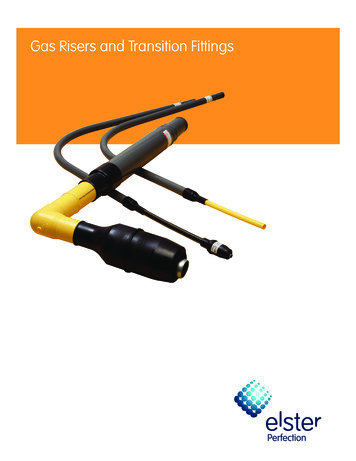![Does Transition Make You Happy? [EBRD - Working Papers]](/img/15/wp0091.jpg)
Transcription
ab0cdDoes transition make you happy?Peter Sanfey and Utku TeksozAbstractThis paper analyses life satisfaction in transition countries using evidence from the World ValuesSurvey. The paper demonstrates that individuals in transition economies on average record lowervalues of self-reported satisfaction with life compared with those in non-transition countries. Aneconometric analysis shows that females, people with higher levels of education and higher incomesare happier, and happiness declines with age until the early-fifties. Self-employed people in transitioncountries show a higher level of satisfaction relative to full-time employees, in contrast to evidencefrom non-transition countries. A comparison across time for a smaller sample of countries shows thatlife satisfaction levels have returned close to pre-transition levels in most cases, after a dip in the mid1990s. In addition, satisfaction levels are highest in those countries where market-oriented reforms aremost advanced and where inequality is lower.Keywords: Happiness; transition; reformsJEL Classification Number: D10, O53, P20Address for Correspondence: European Bank for Reconstruction and Development, One ExchangeSquare, London EC2A 2JN, UK.Phone: 44 20 7338 6227; Fax: 44 20 7338 6111;E-mail: sanfeyp@ebrd.com; teksozu@ebrd.com.Peter Sanfey is a Lead Economist at the EBRD, and Utku Teksoz is an economic analyst at the EBRDand a Ph.D. candidate at the University of Munich.We are grateful to Willem Buiter, Andrew Clark, Tomas Danestad, Pierre Garrouste, Yannis Georgellis,Stephan Klasen, Orsolya Lelkes, Ceema Namazie and Bruce Rayton for helpful comments on anearlier draft.The working paper series has been produced to stimulate debate on the economic transformation ofcentral and eastern Europe and the CIS. Views presented are those of the authors and not necessarilyof the EBRD.Working paper No. 91Prepared in April 2005
INTRODUCTIONLife is often difficult for people living in transition countries. More than fifteen years after thefall of the Berlin wall in late-1989, many individuals in central and eastern Europe and theCommonwealth of Independent States (CIS) are still struggling to adapt to the changes thathave taken place over that period. In most transition countries, the worst is now over: the“transition recessions” of the early- and mid-1990s are past and the region as a whole1 hasbeen growing strongly for several years, out-performing the world economy (see EBRD,2004). Reforms are also proceeding steadily in most countries, bringing substantial benefits inthe form of higher, long-term economic growth.2 But the problems brought by transition arefar from being resolved. In many countries, these include high unemployment, widespreadpoverty and a severe drop in living standards for some of the more vulnerable sections ofsociety.This paper takes a fresh, and somewhat unorthodox, approach to examine the effects oftransition on different segments of society. Rather than analyse “hard” data on income,unemployment, wages and the like, we instead use a subjective, self-determined assessmentof life satisfaction as the measure of an individual’s welfare or utility. This is then correlatedwith socio-economic characteristics such as gender, age, income group and labour marketstatus, as well as with macroeconomic variables and indicators of progress in transition. Theindividual-level data are drawn from the World Values Survey (WVS), a large, multi-countrysurvey that covers a wide range of countries around the world. This data set allows acomparison between transition and non-transition countries, highlighting the extent to whichthe former are different from the latter.Research on the “economics of happiness” is becoming increasingly common amongeconomists. The limitations of self-reported data on well-being and the problems withcomparing answers across individuals, and across countries, are well known. But economistsincreasingly recognise that valuable information can be gleaned from individuals’ responsesto questions about their general welfare. To date, however, few papers have adopted thisapproach in a transition context. This type of analysis may be particularly fruitful fortransition countries, where accurate objective data are often hard to find because ofweaknesses in national statistical agencies and the failure to account for the large informaleconomy. Subjective data can, therefore, give an alternative, complementary perspective onwelfare measurement in the region and the effects – both positive and negative – of transition.This paper attempts to answer several questions. The first question is, do the socio-economicpatterns in life satisfaction observed in non-transition countries also hold in the transitionregion? The answer is that they do to some extent, but with important differences. In thisregard, two results from the transition sample stand out. The first is that the self-employed arehappier than those in full-time employment. This is consistent with the evidence of Dutz et al.(2004) that entrepreneurship is a high-reward strategy for the minority in transition countrieswho have adopted this approach. The second result of interest is that, while satisfaction showsa U-shape pattern when graphed against age (in common with other studies), the declinecontinues into the fifties, whereas the minimum point is usually reached much earlier in nontransition countries.The second question is whether satisfaction is correlated with external macroeconomicvariables such as growth and inflation. In the transition context, relevant questions arewhether the state of reforms and the degree of inequality are important. Our results show apositive relation between reforms, as measured by the well-known EBRD transition indicators,and satisfaction. However, the size and statistical significance of this result is dependent on1The region comprises of the new European Union members of central eastern Europe and the Balticstates (CEB), south-eastern Europe (SEE) and the CIS.2For a review of the recent literature on the relationship between reforms and growth in transition, anda presentation of some new evidence, see Falcetti et al. (2005).1
the specification used and the inclusion of other macroeconomic variables such as GDP percapita. Interestingly, a high degree of inequality in transition countries is associated withlower life satisfaction.Finally, the paper contrasts the results from the most recent wave of the WVS with twoprevious waves, based on a smaller sample of transition countries. A V-shaped patternthrough time is apparent in the majority of countries: that is, average life satisfaction tended tofall during the early years of transition, but returned close to the pre-transition level afterabout a ten-year period, and even above this level in a couple of cases.The paper is structured as follows. Section 1 contains a brief overview of some of the keyrecent literature on the economics of happiness. Section 2 describes the WVS and presentssome summary tables from the latest wave. Section 3 presents the econometric results, basedon ordered probit analysis, on the correlates of life satisfaction. Section 4 contains anextended analysis based on three different waves of the survey, and section 5 concludes thepaper.2
1.HAPPINESS AND TRANSITION: WHAT DO WE KNOW?An exciting development in social sciences in recent years is the growing interaction betweeneconomics and psychology. One of the most visible signs of this phenomenon is the dramaticincrease in interest, especially among economists, in the analysis of subjective measures ofwell-being.3 This literature, commonly known as the “economics of happiness”, has alreadyled to several authoritative surveys in economics journals, as well as a book by two of theleading authors in the area, Frey and Stutzer (2002a).4 The literature has gone a long way toestablish that surveys of individuals’ feelings about their well-being can elicit usefulinformation, that such responses contain predictive power for future behaviour, and that theycan be compared in a meaningful way across individuals, countries and time.Several robust patterns have emerged from a wide number of empirical studies around theworld. For example, it is generally found that happiness is positively correlated witheducation and income, and negatively with unemployment and ill-health. Such results are notsurprising. More unexpected, perhaps, is the fact that overall well-being in industrialisedeconomies does not appear to have increased much or at all over the past decades, despite theenormous increase in real incomes and living standards (see Blanchflower and Oswald, 2004;Layard, 2005). This apparent puzzle is generally explained by adaptation theories, namely,that people become used to new circumstances and adjust their notions of well-beingaccordingly, and by the fact that people are often more concerned with their relative status(compared to those around them) rather than with some absolute measure of income orconsumption. These are highly relevant considerations when analysing transition economies,where the upheavals have been huge and adaptation is likely to take some time, and wherepeople may have inherited a strong aversion to inequality.We make no attempt here to survey the broad literature; instead we concentrate on thosepapers devoted wholly or in part to analysing happiness in transition economies. Thisliterature is rather sparse. Frey and Stutzer (2002b) note that “there is still a lack of data onsubjective well-being in developing and transition countries” (p. 431). Graham (2004) makesthe same point, noting that when such studies exist, they tend to be for individual countriesonly. This is an important gap that needs to be filled, as there are at least two reasons why thistype of analysis is particularly relevant for the region.First, the transition process has involved a major upheaval for most people, and therefore onewould expect to see this reflected in happiness scores, particularly in the early years oftransition. Similarly, measures of happiness would be expected to increase over time ascircumstances have improved and people have become used to the new regime. Thesehypotheses can be tested if one has access to subjective data on transition countries atdifferent stages of transition.Second, objective, reliable data in transition economies are often hard to find. In mostcountries of the region, there is a large informal economy and statistical coverage of thenewly emerging private sector is sometimes patchy. Subjective measures of well-being can,therefore, provide a useful complement to conventional economic data, and can help identifythose groups or regions most affected by transition.3The issue has also attracted considerable media interest recently. See, for example, the special editionof Time magazine entitled “The Science of Happiness”, January 17, 2005, and an article by LarryElliott entitled “Happiness may be in the mind but the state still has a role to play” in The Guardian,February 28, 2005.4Other recent surveys include Oswald (1997), Frey and Stutzer (2002b), and Layard (2005). There isextensive literature on the subject in psychology journals; Diener and Seligman (2004) is a usefuloverview. Other inter-disciplinary initiatives worth noting in this area include an internet site onhappiness research, organised and managed by the sociologist Ruut s/), and a journal called the Journal of Happiness Studies.3
One fact emerges clearly from cross-country surveys of subjective well-being: transitioneconomies consistently appear at or near the bottom of the list. In Veenhoven’s worlddatabase of happiness, there is a summary table on average happiness in 68 nations during the1990s, where happiness is defined as how much people enjoy their life as a whole. Thebottom five countries are (in descending order) Russia, Georgia, Armenia, Ukraine andMoldova, all in the former Soviet Union (FSU). Other transition countries such as Belarus,Bulgaria and the Kyrgyz Republic also score poorly. A similar pattern is apparent in Table 2.2of Frey and Stutzer (2002a), with former Soviet Union countries doing badly on happinessscores and central European transition countries scoring higher but still below not only therichest OECD countries but also most of those in Asia or central and south America.5Halliwell (2002) uses the first three waves of the World Values Survey to estimate a generalhappiness equation for all countries (similar to the approach we adopt below). He aggregatesthe transition countries into two groups – eastern Europe and the former Soviet Union.Interestingly, one experiment shows that subjective well-being was very low in both 1990 andthe mid-1990s in the FSU, while in eastern Europe it started off even lower than in the FSU,but rose significantly in the intervening period.Very few papers focus solely on a range of transition countries.6 Hayo and Seifert (2002)analyse a subjective measure of economic well-being in ten eastern European countries in theearly 1990s. This measure has a reasonably strong correlation with life satisfaction in the firstwave of the survey in 1991 (the only year when both questions were asked). It is alsocorrelated with GDP per capita, with the correlation rising over time, suggesting thatobjective data have become more accurate over time.A number of other papers analyse the correlates of happiness in a specific country. Namazieand Sanfey (2001) focus on one of the poorest transition countries – the Kyrgyz Republic –using a household survey carried out in 1993. While some of the results are similar to those inempirical studies of more advanced countries, several are different. In particular, satisfactionappears to decline steadily with age, at least until the early sixties, in contrast to the U-shapepattern (with a mid-point somewhere around 40) commonly found in more advancedcountries. 7 Also, there is no correlation between happiness and education in transitioncountries, possibly (the authors speculate) because skills and education acquired under the oldregime are of little use in the new circumstances.Several papers examine happiness in Russia. For example, Veenhoven (2001) and Graham etal. (2004), both find high levels of unhappiness on average among Russians. Similar toNamazie and Sanfey (2001), Graham et al. also fail to find a significant impact of educationon happiness in most specifications, while a U-shape does emerge with respect to age, butwith a minimum around 47 years. Interestingly, however, the panel nature of the data allowsthe authors to identify tentatively a two-way causal effect between income and happiness.Senik (2002) identifies an important positive contribution to happiness by the relevant“reference” income. Another interesting finding is that the self-employed in Russia tend to behappier than employees, in contrast to evidence from Latin America (see Graham, 2004).However, this finding is not replicated in Lelkes’s (2002) findings for Hungary.85One possible explanation for the low scores in some countries is the fact that many young, educatedpeople with entrepreneurial skills have emigrated during the transition, and it is those people who, onaverage, tend to report higher satisfaction scores.6Gruen and Klasen (2005) is a work in progress that looks at developments in a range of indicators,including subjective ones, during the transition to assess overall changes in welfare throughout theperiod.7See, for example, Clark et al. (1996).8The author has pointed out to us that a possible reason for this finding is a data problem, wherebymany employees declare themselves as “self-employed” purely for tax purposes. Also, the well-beingof the self-employed in Hungary appears, from the same research, to have increased over time.4
2.THE WORLD VALUES SURVEY DATAAll of the micro data used in the present paper comes from the integrated data set of WorldValues Survey and European Values Survey (WVS-EVS, or WVS for short).9 These surveysare a major multi-country effort to gain insight into people’s basic values and attitudes acrossa broad range of issues, including politics and economics, family and religious values, genderissues and environmental awareness. The WVS has been implemented in four waves so far:(i) 1981-84, (ii) 1990-93, (iii) 1995-97, and (iv) 1999-2002. The first wave covered only 24societies.10 The sample grew with the second wave which covered 43 societies. The third andthe fourth waves covered 62 and 82 societies respectively. Thus, the latest wave of the WVScovers countries that together account for about 85 per cent of the world’s population. Thissection and the following section focus on wave four only, which includes 19 transitioncountries (see Annex), while section 5 considers evidence from the earlier waves.For our purposes, the key question from the WVS is the following, to which respondents wereasked to mark their answers on a scale from 1 (most dissatisfied) to 10 (most satisfied):“All things considered, how satisfied are you with your life as a whole these days?”The answers vary widely both within and across countries. Figure 1 considers the crosscountry variation. It shows the mean score, by country, of the responses and compares it witha measure of objective well-being, namely GDP per capita (in current international dollars)adjusted for purchasing power parity (PPP). Since the fourth wave of the WVS-EVS wascarried out over a three-year interval between 1999 and 2002, we tracked the exact timing ofthe survey implementation for each country, and assumed a one-year lag in GDP per capitafigures in relation to the time of the survey. That is, if the survey was implemented in countryX in 2001, then we compare it with the GDP per capita (PPP-adjusted) of country X in 2000.The evidence in Figure 1 shows the expected positive relationship between GDP per capitaand self-reported satisfaction, though the link between the two appears to tail off at higherlevels of GDP per capita. In fact, a simple quadratic trend fits the relation quite well, with asignificant correlation of 0.74 between the two series. Interestingly, most transition countriesfall below this trend, with only Croatia, the Czech Republic and the Slovak Republic (three ofthe most advanced countries in the region) lying above the trend.11 That is, people in mosttransition countries tend to report lower levels of satisfaction than would be predicted by aquadratic regression of satisfaction on GDP per capita. This is the first bit of evidence fromthe latest wave of the WVS of the difficulties faced by individuals in the region.9European and World Values Surveys are carried out by two separate groups of researchers, and areintegrated in a data file for research purposes to ensure cross-national and across-time comparisons.10The common units of analysis in this dataset are countries. However, societies in this context areintroduced as a broader concept, since occasionally some samples, which are regionally rather thannationally representative are also surveyed. For example, Andalucia, Basque Country, Galicia, andValencia as well as a national representative sample for Spain were surveyed in wave three. For ourpractical purposes, only sovereign countries were included in the econometric analyses.11With the exception of Serbia and Montenegro, which has been treated as two separate entities by theWVS-EVS. However, comparable macroeconomic data on GDP per capita for this country were notavailable at this level of disaggregation.5
Figure 1Income vs. Life satisfaction98Life satisfaction7Czech RepSloveniaCroatiaPoland Slovak RepBosnia and HerzEstonia HungaryBulgaria LatviaRomania LithuaniaAlbaniaBelarus65Ukraine Russia4305,000 10,000 15,000 20,000 25,000 30,000 35,000 40,000 45,000GDP per capita (dollars)Source: WVS and World Development Indicators.Table 1 contains a more detailed examination of where transition countries stand in relation toother countries. The table shows that four countries in the region – Moldova, Ukraine, Russiaand Belarus – are in the bottom decile in terms of satisfaction scores. Two of the Baltic states– Latvia and Lithuania – are in the next-to-bottom category, along with Albania, FYRMacedonia and Romania. In general, the new EU members score much better, with Slovenia(the richest country in the region in terms of GDP per capita) in the 70-80 decile and theCzech Republic in the 60-70 category. Slovenia’s score of 7.23 puts it above France (7.01)and not far off from Great Britain and Germany (7.40 and 7.42 respectively) in terms of lifesatisfaction.Another way of comparing subjective measures of satisfaction with objective economiccircumstances is to compare the responses to the question above with cumulative growth overthe transition period (see Figure 2). People’s assessments of their well-being are ofteninfluenced by their economic situation relative to what it used to be, rather than by theabsolute standard of living. Indeed, this is one of the reasons why the link between GDP andhappiness is much weaker once countries manage to rise to a point of reasonable prosperity.All transition countries suffered deep recessions in the early years of transition, though theduration and extent of the decline in real output varied widely from one country to the next.As Figure 2 shows, there is indeed a positive correlation between two variables: lifesatisfaction (on the y-axis), and an index of real GDP that takes the value of 100 for allcountries in 1989 (on the x-axis). The correlation coefficient between the two variables is 0.54.However, there is considerable variation across countries, suggesting that many other factorsare driving the responses to this question. The next section, therefore, uses econometrictechniques to investigate more deeply the correlates of life satisfaction.6
Table 1: Mean of life satisfaction scores and the lowest percentiles by countryLowest percentilesCountryLife larus4.81FYR tvia5.27Bulgaria5.50Serbia5.62Montenegro5.64Bosnia and Herzegovina5.77Hungary5.80Estonia5.93Slovak ech Republic7.0670-80Slovenia7.2310-2020-3030-40Note: The table shows the average satisfaction score by country, and the corresponding decile intowhich each country falls.Source: WVS.Figure 2:Life satisfaction vs. GDP Growth-Transition Countries8.00SloveniaCzech RepLife satisfaction7.00CroatiaPolandSlovak Rep6.00Bosnia and HerzSerbia 003.002.002030405060708090Real GDP Index (1989 100)Source: WVS and EBRD (2004).7100110120
3.ECONOMETRIC SPECIFICATION AND RESULTSSo far, this paper has looked at aggregate satisfaction scores across countries and theirrelationship with GDP. However, in order to derive a better understanding of what drivespeople’s responses to this question, we estimate a series of microeconometric equations. Ourhypothesis is that self-reported satisfaction scores are a function both of individual-specificand economy-wide variables. We, therefore, estimate the following equation:Sij f(Xij, Zj, εij),(1)where Sij is a vector of satisfaction scores (on a scale of 1 to 10) of individual i in country j,Xij is a matrix of explanatory variables that vary across individual and country, Zj is a matrixof macroeconomic variables that vary by country only, and εij is a vector of idiosyncraticerrors.In line with much of the previous literature, we include the following microeconomicvariables (all of which are taken from the WVS): gender, marital status, income group,employment status, education, and age variables. Marital status is divided into married, livingtogether, divorced, separated, widowed, and single. Income group is divided into threedummy variables: lower income, middle income and higher income groups. The breakdownof the employment status variable is as follows: full-time (30 hours a week and more), parttime (less than 30 hours a week), self-employed, retired, housewife, student, unemployed andother. The education variable is split into: inadequately completed elementary education,completed (compulsory) primary education, incomplete secondary education (technical,vocational type), complete secondary school (technical, vocational type), incompletesecondary school (university preparatory type), complete secondary school (universitypreparatory type), some university education without degree, and finally university educationwith degree.The macroeconomic variables in equation (1) include GDP per capita (PPP-adjusted), theunemployment rate, the inflation rate and the Gini coefficient, which captures the impact ofincome inequality on satisfaction. In addition, the state of reform may also be relevant forhappiness in transition countries. We, therefore, include the average transition score for eachcountry, as measured by the EBRD transition indicators.12 It is unclear a priori what the signof this variable may be. On the one hand, progress in transition is generally associated withbetter economic performance, and hence a higher degree of satisfaction. On the other hand,transition is a time of upheaval and disruption, and it is possible that people in countries thatlag behind in transition are (other things being equal) happier for that reason. We alsoexperiment by dividing this variable into initial-phase reforms, which capture progress inprice liberalisation, foreign exchange and trade liberalisation and small-scale privatisation,and second-phase reforms, which include large-scale privatisation, governance and enterpriserestructuring, competition policy, infrastructure, banking and interest rate liberalisation, andnon-bank financial institutions (see the data Annex for more details).Up to now, we have for convenience treated our dependent variable – life satisfaction – as acardinal measure when taking within-country averages and comparing across countries.However, there is no presumption that the difference between a score of 4 and 5, for example,is the same as that between 5 and 6. Therefore, in line with most of the recent literature, wetreat this variable in our estimation procedure as ordinal and estimate equation (1) by anordered probit model, rather than by ordinary least squares. In the discussion that follows, apositive (and statistically significant) coefficient on an explanatory variable indicates a12The transition indicators range from 1 (little or no progress in reform) to 4 (standards of anadvanced industrialised economy). When calculating averages, pluses and minuses are converted tonumerical equivalents by adding or subtracting 0.33 (e.g., 2 becomes 2.33 and 3- is 2.67). See theEBRD Transition Report, various issues, for a full description of the methodology underlying thesescores.8
positive association with life satisfaction, in the sense that it increases the probability of beingin the highest category (satisfaction 10) and decreases the probability of recording thelowest score (satisfaction 1).13Table 2 presents the results of the ordered probit regressions for the whole sample, thetransition countries sample and the non-transition countries sample, respectively in columnsone to three. Our initial approach is to capture country-specific fixed effects by addingcountry dummies, rather than including the macroeconomic variables discussed above. Wealso include employment status, marital status, education, income group, age and age squared,all of which have been shown elsewhere to be important determinants of life satisfaction.Turning first to column 1 of Table 2, which includes both transition and non-transitioncountries, many of the results parallel those of other cross-country studies. For example, mostcategories of employment status are associated with lower values of satisfaction relative tofull-time employment (the omitted category in the regression). Unemployment has aparticularly negative effect on satisfaction; other things being equal, being unemployed ratherthan full-time employed raises the probability of recording the lowest level of satisfaction byapproximately three percentage points. Satisfaction tends to rise with educational status,particularly at high levels of education, and with income, while being married is associatedwith more satisfaction than other types of living arrangements. Finally, the data exhibit thefamiliar U-shape pattern with regard to age, with a minimum point at around age 46, andshow males are less happy than females, a finding that appears in several other studies.14 Thecountry dummies for transition countries (not reported in the table) are almost all negative andstatistically significant relative to the reference country, Germany.Columns 2 and 3 report the results from the same regression model for transition and nontransition countries respectively. A quick glance at the results shows a large number ofsimilarities between the two sub-groups, but also some important differences. It is the latterthat are of most interest here. Turning first to employment status highlights one of the mostinteresting results: self-employment in transition countries is positively (and statisticallysignificant at 10 per cent) associated with satisfaction, whereas the sign is reversed in the nontransition case. There is evidence from previous research that, for those willing to take therisk, self-employment is a successful coping strategy in transition (see, for example, EBRD,2000, Chapter 5, and Dutz et al., 2004). 15 The results in column 2 are an interestingcomplement to this earlier research, and highlight the importance of further developingentrepreneurship in the transition context.A second interesting contrast between the two samples concerns th
surprising. More unexpected, perhaps, is the fact that overall well-being in industrialised . of Time magazine entitled “The Science of Happiness”, January 17, 2005, . there is a summary table on average happiness in 68 nations during the 1990s, where happiness is de










